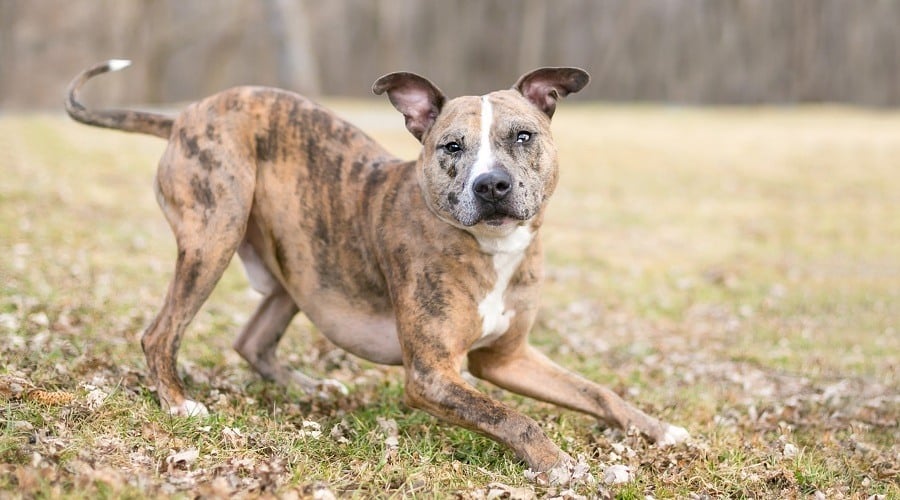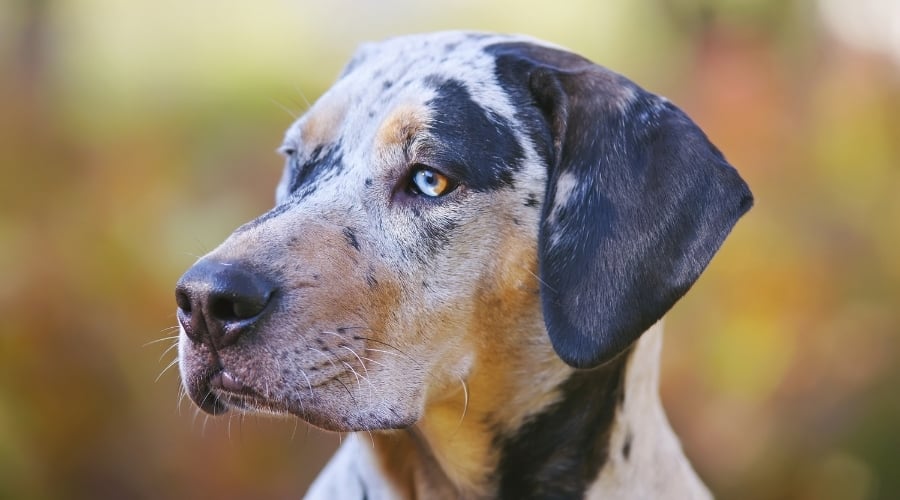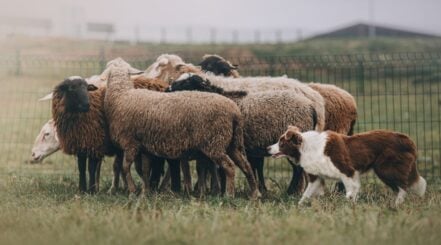The Catahoula Leopard Dog, also known by the monikers Catahoula Hog Dog, Catahoula Cur, and Louisiana Catahoula, is the only breed with roots in Louisiana. A medium to large, independent, working dog, the Catahoula is strong-bodied and strong-willed. The National Association of Louisiana Catahoulas has the motto, “not everyone needs a Catahoula.”
Catahoula Leopard Dogs are known for their unique coloration and muscular build. Particularly suited to hot, humid weather, these short-coated dogs are uniquely marked and can have any eye color. They can even have nearly white eyes, and two different eye colors in one dog are not unusual.
The history of the Catahoula is the stuff of legend; likely, at least part of the legend is fictional. Powerful dogs which take their job seriously, Catahoulas are not for inexperienced dog owners. They require firm guidance and early socialization to be trustworthy family members.
Breed History

While the breed histories suggested for the Catahoula are full of famous names, these histories are likely at least partially fiction. One popular theory about the origin of the Catahoula states that Hernando de Soto’s war dogs and Native American dogs derived from the Red Wolf interbred to create the breed’s foundation. These progenitors to the Catahoula would have origins dating to de Soto’s destructive path across the Southeast in the 1540s, but there’s no actual documentation to back up the legend.
A second theory also suggests Red Wolves in the Catahoula’s gene pool. In this version, Red Wolf was introduced in the 1800s when French settlers bred their Beaucerons to Native American dogs. Recent DNA evidence suggests the Native dogs may not have Red Wolf in their lineage but instead traced back to dogs brought from Europe and Asia with the first Native Americans to come to the Americas.
Later legends suggest that brothers Jim and Rezin Bowie, of Alamo and Bowie knife fame, were fans of the Catahoula and even slept with one at their feet. Catahoulas also factor in Presidential legend. Teddy Roosevelt reportedly used a pair of Catahoulas in his pack of bear-hunting dogs on his 1907 hunting expedition in Louisiana. In 1979, the Governor of Louisiana signed a bill declaring the Louisiana Catahoula Leopard Dog the official State Dog of Louisiana.
Temperament
Catahoulas are working dogs, and breeders actively try to retain this working character. Their independent and assertive nature means Catahoulas need careful socialization from puppyhood through maturity. They don’t accept harsh training methods or mistreatment and may act in self-defense if handled roughly.
If raised carefully by experienced handlers, Catahoulas are gentle with and intensely loyal to their family. The National Association of Louisiana Catahoulas (NALC) sponsors Instinct Trials and Obedience Trials in Louisiana and other states. Catahoulas still work and guard livestock for some of their families as well.
Size & Appearance

Catahoula Leopard Dogs have impressive size and substance. Between 22 and 24 inches at the shoulder and fifty to ninety-five pounds, the Catahoula’s medium to heavy frame is amply muscled. The original Catahoulas were strong and agile enough to handle the wild hogs and cattle that ran loose in the early days of Louisiana’s settlement. Catahoula Dog’s bodies reflect their mixed ancestry. A blend of Native Dogs with bloodhounds, mastiffs, and greyhounds, Catahoulas display each ancestral breed’s size, strength, and agility.
Coat & Colors
One of the most popular traits of the Catahoula is his unique coloration. The Catahoula coat is short and easily kept, but his range of colors is extensive due to the merle gene that causes his striking pattern. Several other dog breeds carry the merle gene, but merle parents aren’t crossed in hopes of reducing the risk of health problems in double merle (predominantly white) individuals.
Breeding for color has made solid Catahoulas relatively rare. Most carry the merle gene. The gene that causes the coloring, SILV or Silver locus Pmel17, is a pigment dilution gene that explicitly affects hair and eye color. The typical merle/leopard coat is caused by the heterozygous M/m, and the predominantly white double merle is M/M. Double merle pups are often born deaf, blind, or both. Some may have microphthalmia (shrunken eyes) or be born with no eyes at all. Nearly 80% of Louisiana Catahoulas tested had the merle gene.
The “Leopard” in the Catahoula’s name refers to his striking merle pattern that may be blue (based on gray or black), red, white, liver, and patched, although he may be a solid color, including black, red, chocolate, yellow, and brindle. Catahoula’s eye color is just as attractive as his coat color. He may have one or both eyes a single color, a blend of colors, or nearly white. Nearly white eyes are known as “glass eyes” and are the preferred eye color. Catahoula eyes may be brown, green, blue, glass, or combinations within the same iris.
Living Conditions
Louisiana Catahoulas were developed in an area that remains relatively warm in the winter and can be very hot and humid in the summer. Because Catahoulas have a short coat that helps them handle Louisiana summers, they aren’t a natural fit for outdoor living where the winters are frigid. They’ll need protection from cold weather and a shady spot to rest in the summer.
Lake Catahoula in Catahoula Parish, Louisiana, is believed to have gotten its name from the Choctaw word Okkattahoula, which means beautiful, clear water or sacred lake. Bred to run and work in the wild outdoors of woods and swamps, Catahoulas enjoy having space to run and play in a securely fenced backyard. Catahoulas were bred to be hunting and herding dogs, so finding activities to do with your Catahoula based on his instincts helps keep him mentally satisfied and physically healthy. If you don’t have livestock to work with your dog or want to participate in organized sporting events, a daily jog with you helps him burn off some of his considerable energy.
Training

Before getting a Catahoula puppy, have a plan in place for his training. Although Catahoulas want a job and are eager to please, their high energy level and herding drive make them challenging for inexperienced handlers. Catahoulas are protective of their family and should be taught basic obedience early, so they understand their place in the family. Early socialization helps your Catahoula be more willing to accept strangers in his space.
Health
Hearing Loss
Although Catahoulas come in many colors, mainly white dogs are predisposed to a higher incidence of deafness than many other breeds. White Catahoulas may be congenitally deaf, which means they are deaf from birth. Dogs with hearing loss can make excellent pets, but they startle easily, which can be a problem in a dog with this power. You’ll have to adjust how you handle your dog to accommodate his condition.
Joint Dysplasia
As with many large breeds, Catahoulas may suffer from joint dysplasia, a painful condition that limits mobility. Breeding dogs should have an Orthopedic Foundation for Animals (OFA) or PennHIP Evaluation, and buyers should choose puppies from parents with good evaluation scores. Your veterinarian can recommend a feeding program for your pup designed to promote slow, steady growth, which may help limit the development of growth-related joint dysplasia.
Eye Problems
Double merle Catahoulas may be born partially or fully blind. They could even lack eyes completely or suffer from particularly small eyes. This serious condition is irreversible, and care should be taken to avoid breeding merle to merle if possible and cull any dogs born with defects from the breeding pool by responsibly spaying or neutering the individual.
Nutrition
Free-choice feeding a growing large breed pup may not be a good idea. Growing pups eat more than mature dogs. Follow the feeding chart on the feed brand, but be sure to choose a puppy food that meets Association of American Feed Control Officials (AAFCO) standards and is designed specifically for large breed dogs. These formulas help mitigate the risk of musculoskeletal problems like joint dysplasia related to rapid growth.
Your dog may eat between three and four cups per day as an adult, depending on his activity level. Feeding the best quality nutrition that you can afford may be more cost-effective in the long run than skimping with a bargain brand of kibble. To keep this active breed healthy, look for a large breed formula matching his age. A high-quality kibble including meat protein, fiber, healthy carbs, omega-3 fatty acids, vitamins, and minerals will meet his nutritional needs. You’ll be less likely to have to add costly supplements.
Grooming
As weather allows, you may bathe your Catahoula Dog once every four to six weeks with a shampoo and conditioner made specifically for dogs. This breed sheds seasonally, but brushing him a few times weekly with a bristle brush will help remove the dead hair and keep his coat healthy. His short, sleek coat benefits from regular currying with a hound mitt to stimulate oil production in his skin.
With a two-sided grooming mitt, hair loosened while currying can be brushed out immediately. Although Catahoulas are low maintenance to groom, but their strong, fast-growing nails need regular trimming or grinding. Brush your dog’s teeth regularly with veterinary toothpaste.
Breeders & Puppy Costs

Louisiana Leopard Catahoula Dogs usually cost between $600 and $900. While their cost remains reasonable, their relative rareness may make finding an available puppy difficult. If you live in a Gulf Coast state, you’ll be close to more Catahoula breeders than if you are in a part of the country more distant from Louisiana. Check the breeder’s references thoroughly if you purchase a pup sight unseen and have it shipped.
Rescue & Shelters
In areas where Catahoulas are common, you may find individuals in rescues and shelters. As the NALC states in its motto, “not everyone needs a Catahoula.” If you find a Catahoula who has been brought to a shelter, ask yourself if you have the experience and patience to retrain a dog who may not have been handled appropriately for the breed in his prior situation. Several Catahoula rescues exist. Try Catahoula Rescue Me, Janeen’s Catahoula Dog Rescue, Catahoula Rescue Southeast, or Blackjack Animal Rescue for more information on available rescue or foster Catahoulas.
As Family Pets
In general, this breed is:
- A friendly, hardworking dog.
- Best suited to an experienced dog owner.
- Protective of his family and home.
- Aloof with strangers unless adequately socialized.
- High-energy.
- Healthiest with about an hour total of daily exercise.
- Loyal to his family
- Destructive when bored and left alone for extended periods.
- Best in a home with a large yard unless you can otherwise meet his exercise needs.
Final Thoughts
If you have experience with strong-willed breeds and are interested in an addition to the family who can work your herd and turn heads with his unique coloration, the Catahoula Leopard Dog may be the breed for you. This athletic and outgoing breed reflects the rugged beauty of Louisiana. If you are looking for a buddy as high-energy and adventurous as you are, the Catahoula may be your perfect match.






My dad raised and bred Blue leopards.We trained them mainly to hunt and catch hogs. I believe no other dogs are better suited for this type of hunting.Our dogs were what they called big headed Catahoulas cures.Usually one or both eyes were glassed.( Dad would say if they could lock on a train with their teeth and set down )That train would be stopped..And I would agree.!